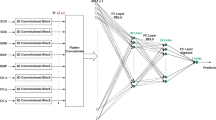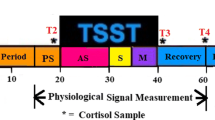Abstract
The problem of stress detection and classification has attracted a lot of attention in the past decade. It has been tackled with mainly two different approaches, where signals were either collected in ambulatory settings, which can be limited to the period of presence in the hospital, or in continuous mode in the field. A sensor-based continuous measurement of stress in daily life has a potential to increase awareness of patterns of stress occurrence. In this work, we first present a data-flow infrastructure suitable for two types of studies that conforms with the data protection requirements of the ethics committee monitoring the research on humans. The detection and binary classification of stress events is compared with three different machine learning models based on the features (meta-data) extracted from physiological signals acquired in laboratory conditions and ground-truth stress level information provided by the subjects themselves via questionnaires associated with these features. The main signals considered in current classification are electro-dermal activity (EDA) and blood volume pulse (BVP) signals. Different models are compared and the best configuration yields an \(F_1\) score of 0.71 (random baseline: 0.48). The importance on prediction of phasic and tonic EDA components is also investigated. Our results also pave the way for further work on this topic with both machine learning approaches and signal processing directions.
This project is funded by the University of Applied Sciences and Arts of Western Switzerland.
F. Albertetti and A. Simalastar—Both authors contributed equally to this paper.
Access this chapter
Tax calculation will be finalised at checkout
Purchases are for personal use only
Similar content being viewed by others
References
La commission cantonale (VD) d’éthique de la recherche sur l’être humain. http://cer-vd.ch/
Barreto, A., Zhai, J., Adjouadi, M.: Non-intrusive physiological monitoring for automated stress detection in human-computer interaction. In: Lew, M., Sebe, N., Huang, T.S., Bakker, E.M. (eds.) HCI 2007. LNCS, vol. 4796, pp. 29–38. Springer, Heidelberg (2007). https://doi.org/10.1007/978-3-540-75773-3_4
Bogomolov, A., Lepri, B., Ferron, M., Pianesi, F., Pentland, A.: Daily stress recognition from mobile phone data, weather conditions and individual traits. In: Proceedings of the 22nd ACM International Conference on Multimedia, pp. 477–486 (2014)
Boucsein, W.: Electrodermal indices of emotion and stress. In: Electrodermal Activity, pp. 369–391 (1992). Chapter 3
Boucsein, W., et al.: Society for psychophysiological research ad hoc committee on electrodermal measures. Publication recommendations for electrodermal measurements. Psychophysiology 49(8), 1017–1034 (2012)
Ciabattoni, L., Ferracuti, F., Longhi, S., Pepa, L., Romeo, L., Verdini, F.: Real-time mental stress detection based on smartwatch. In: 2017 IEEE International Conference on Consumer Electronics (ICCE), pp. 110–111. IEEE (2017)
Doberenz, S., Roth, W.T., Wollburg, E., Maslowski, N.I., Kim, S.: Methodological considerations in ambulatory skin conductance monitoring. Int. J. Psychophysiol. 80(2), 87–95 (2011)
Han, H., Byun, K., Kang, H.G.: A deep learning-based stress detection algorithm with speech signal. In: Proceedings of the 2018 Workshop on Audio-Visual Scene Understanding for Immersive Multimedia, pp. 11–15 (2018)
Hernando, A., et al.: Inclusion of respiratory frequency information in heart rate variability analysis for stress assessment. IEEE J. Biomed. Health Inform. 20(4), 1016–1025 (2016)
Kurniawan, H., Maslov, A.V., Pechenizkiy, M.: Stress detection from speech and galvanic skin response signals. In: Proceedings of the 26th IEEE International Symposium on Computer-Based Medical Systems, pp. 209–214. IEEE (2013)
Liao, C.Y., Chen, R.C., Tai, S.K.: Emotion stress detection using EEG signal and deep learning technologies. In: 2018 IEEE International Conference on Applied System Invention (ICASI), pp. 90–93. IEEE (2018)
LiKamWa, R., Liu, Y., Lane, N.D., Zhong, L.: MoodScope: building a mood sensor from smartphone usage patterns. In: Proceeding of the 11th Annual International Conference on Mobile Systems, Applications, and Services, pp. 389–402 (2013)
Marchand, A., Juster, R.P., Durand, P., Lupien, S.J.: Burnout symptom sub-types and cortisol profiles: what’s burning most? Psychoneuroendocrinology 40, 27–36 (2014)
Posada-Quintero, H.F., Florian, J.P., Orjuela-Cañón, A.D., Chon, K.H.: Electrodermal activity is sensitive to cognitive stress under water. Front. Physiol. 8, 1128 (2018)
Salahuddin, L., Jeong, M.G., Kim, D., Lim, S.K., Won, K., Woo, J.M.: Dependence of heart rate variability on stress factors of stress response inventory. In: 2007 9th International Conference on e-Health Networking, Application and Services, pp. 236–239. IEEE (2007)
Sano, A., Picard, R.W.: Stress recognition using wearable sensors and mobile phones. In: 2013 Humaine Association Conference on Affective Computing and Intelligent Interaction, pp. 671–676. IEEE (2013)
Schmidt, P., Reiss, A., Duerichen, R., Marberger, C., Van Laerhoven, K.: Introducing WESAD, a multimodal dataset for wearable stress and affect detection. In: Proceedings of the 20th ACM International Conference on Multimodal Interaction, pp. 400–408 (2018)
Schneiderman, N., Ironson, G., Siegel, S.D.: Stress and health: psychological, behavioral, and biological determinants. Annu. Rev. Clin. Psychol. 1, 607–628 (2005)
Shukla, J., Barreda-Angeles, M., Oliver, J., Nandi, G., Puig, D.: Feature extraction and selection for emotion recognition from electrodermal activity. IEEE Trans. Affect. Comput. (2019)
Stalder, T., et al.: Assessment of the cortisol awakening response: expert consensus guidelines. Psychoneuroendocrinology 63, 414–432 (2016)
Zubair, M., Yoon, C., Kim, H., Kim, J., Kim, J.: Smart wearable band for stress detection. In: 2015 5th International Conference on IT Convergence and Security (ICITCS), pp. 1–4. IEEE (2015)
Author information
Authors and Affiliations
Corresponding author
Editor information
Editors and Affiliations
Rights and permissions
Copyright information
© 2021 ICST Institute for Computer Sciences, Social Informatics and Telecommunications Engineering
About this paper
Cite this paper
Albertetti, F., Simalastar, A., Rizzotti-Kaddouri, A. (2021). Stress Detection with Deep Learning Approaches Using Physiological Signals. In: Goleva, R., Garcia, N.R.d.C., Pires, I.M. (eds) IoT Technologies for HealthCare. HealthyIoT 2020. Lecture Notes of the Institute for Computer Sciences, Social Informatics and Telecommunications Engineering, vol 360. Springer, Cham. https://doi.org/10.1007/978-3-030-69963-5_7
Download citation
DOI: https://doi.org/10.1007/978-3-030-69963-5_7
Published:
Publisher Name: Springer, Cham
Print ISBN: 978-3-030-69962-8
Online ISBN: 978-3-030-69963-5
eBook Packages: Computer ScienceComputer Science (R0)




